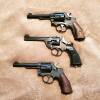Howdy
The Serial Number of your revolver is the number stamped on the bottom of the butt. I do not know what the number scratched on the side of the frame is, but it is not the SN. Perhaps a rack number put there by a police armorer. The serial number has been stamped onto the inside of one of the grips, at the factory, indicating that it left the factory with those grips.The number stamped on the frame under the yoke is an assembly number, it does not mean anything.
Your serial number with the V prefix indicates your Victory model has the old style hammer block inside. A Victory model with that style hammer block was involved in a ship board accident in 1944. The gun fell to the deck and discharged and killed a sailor. S&W did a crash redesign of the hammer block and came up with the design that has been inside every S&W revolver since 1944. It is speculated that hardened cosmoline inside the revolver prevented the older style hammer block from functioning properly, and when the hammer struck the deck, the revolver discharged.
After the shipboard incident, about 40,000 revolvers were sent back to S&W for modification to the new hammer block design. Revolvers modified this way had a S added to the serial number, so the prefix changed to SV The rest of the production run of Victory Models also had the new hammer block inside, and they too had the SV prefix. Just be careful, many thousands of S&W revolvers were made with the old style hammer block and failure was quite rare. Just don't drop it on the hammer with a live round under the hammer.
This is the style of hammer block that will be inside your Victory Model. The angled part attached to the side plate.

Yes, I am pretty sure the U. S. PROPERTY marking was applied by S&W. The G.H.D marking is for Guy H. Drewry, who was the government inspector from 1930 until 1957. He would probably have been a government employee, but working in the S&W plant to inspect the revolvers.
Victory Models were made from 1942 until 1945. About 242,291 were made. It is difficult to pin down exactly when yours was made, I have one with the Serial Number of V4224XX and I have never tried to figure out exactly when it shipped.
Lend Lease guns did not just go to England, some went to Russia and other Allied countries.
See if you can find a British Broad Arrow on it anywhere. That would confirm that it was accepted in Britain.
This mark is a Canadian Broad Arrow on a revolver that was sent to Canada in 1916. This revolver has the Broad Arrow inside a C for Canada. The standard British Broad Arrow will be the three lines which represent the head of an arrow.























